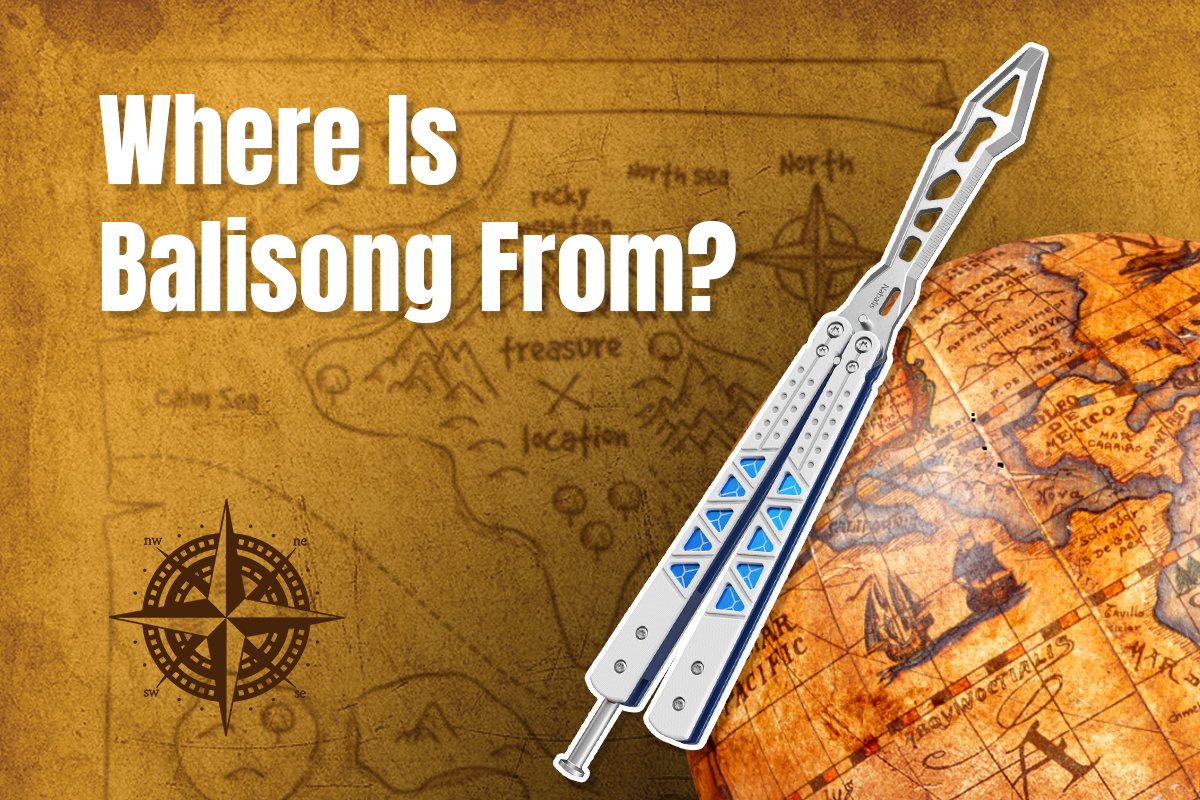Butterfly knives, also recognized as balisongs, stand as one of the most sought-after knife styles in contemporary times.
As a member of the balisong community, have you ever had this question in your mind? Where the balisong came from and what it was used for in the original time?
Well today I’m going to do my best to enlighten you on the origin of butterfly knives! No need to wait, let's kick things off!
Where Did Butterfly Knife Originate?
“Where Were Butterfly Knives originated?” Approach a balisong enthusiast and ask. And you might receive two distinct answers.
Butterfly knives boast a storied history, a significant portion of it remains shrouded in speculation. Unclear historical records and long-standing legends share responsibility.
The primary countries under scrutiny are France and the Philippines, with both presenting evidence and having their respective supporters.
Butterfly Knife Origin in Philippines

The origin of the butterfly knife, or "balisong," is frequently attributed to the Philippines, where the term "balisong" is considered more fitting.
According to legend, the balisong knife's roots can be traced back to approximately 800 AD.
This unique knife design allowed for quick one-handed opening and proved to be a versatile tool, serving both as a self-defense weapon and a utility implement.
For over a century, the Philippines has maintained a rich tradition of balisong craftsmanship.
Today, numerous stands and stores offer handmade butterfly knives, with the Filipino province of Batangas and the Balisong area in Taal gaining recognition for their blade-making expertise.
While the term "balisong" is widely associated with its Philippine origins, the absence of substantial physical evidence to support this claim fuels the ongoing debate about its true origin.
Butterfly Knife Origin In French
Another assertion regarding the origin of the butterfly knife places its invention in France between the years 1500 and 1700.
This assertion is based on the existence of the "Pied Du Roi," which translates to "foot of the king," a French measuring tool dating back to the 1700s.
Notably, the "Pied Du Roi" bears a striking resemblance to a butterfly knife, featuring measurement handles and a folding blade at one end.
While it closely resembles a butterfly knife, the question remains whether it can be considered the very first one ever created.

Advocates of the French origin argue that Spain, in alliance with France during that period, adopted the butterfly knife for various tasks and may have subsequently introduced it to the Philippines as sailors traveled to different countries.
This hypothesis seems plausible but lacks concrete proof.
Support for the French origin also stems from the existence of butterfly knives in Germany and England, where some examples can be traced back to before 1900.
Recently, I came across a collector's piece online that was crafted in England, with markings dating back to 1873. This discovery challenges the notion of the butterfly knife originating in the early 1900s in the Philippines.
However, it should be noted that claims have also been made that the design was influenced by similar Filipino knife models dating as far back as 800 AD.
Evolution History Of Butterfly Knife, Philippines To America
In the early 800 AD, the balisong, also known as the butterfly knife, fan knife or Batangas knife, evolved into a versatile tool for Filipino farmers and fishermen.
They seamlessly integrated it into their daily routines, using it to cut rope, open coconuts, and scale fish.
Additionally, it found its place in Filipino martial arts, such as Kali and Escrima, where it became an indispensable weapon for self-defense and combat.
Throughout the 20th century, the balisong's prominence in the Philippines continued to rise. Skilled Filipino knife makers honed their craft, specializing in the creation of these unique knives.
The design of the balisong evolved, featuring a blade and two handles interconnected by a pivot system. Notably, brass, steel, and wood were common materials used for crafting the handles in acient Philipines.

The balisong gained significant recognition as a weapon during World War II when American soldiers stationed in the Philippines encountered this distinctive knife.
They were captivated by its design and brought it back to the United States, where it found favor among knife collectors and enthusiasts.
Approximately two decades later, during the 1950s and 1960s, the balisong experienced another surge in popularity in the United States. This time, it found a strong following among motorcycle gangs.
Unfortunately, it also became associated with violence and frequently appeared in movies and TV shows as a dangerous weapon. Consequently, many states began to enact bans on the possession and use of balisongs, leading to a significant decline in its popularity.
However, in the 1980s, the balisong once again enjoyed a resurgence in popularity, particularly among knife enthusiasts and collectors.
Nowadays, the surge in popularity of butterfly knives, often referred to as balisongs, can be attributed to the enjoyment of "flipping."
Flipping involves skillfully manipulating butterfly knives to perform a wide array of tricks. Whether it's the element of risk, the community, the allure of collectibles, or other factors, there's no denying that watching flippers in action is utterly captivating.
What’s The Meaning Of The Origins And History of Balisong
You might look at the different origins and historry above and think, "Obviously, butterfly knives were originated in the Philippines because 800 AD predates the 1600s or 1700s."
However, others may argue, "There is no solid, documented proof that the balisong was initially invented in the Philippines.
Much of this information has been passed down through oral tradition. Instead, they might attribute the creation of the balisong to France, as they possess tangible historical documentation regarding the balisong's origins."
Regardless of where butterfly knives originated, I don't necessarily reckon we should dismiss the idea that butterfly knives could have originated in the Philippines or in France.
It's valuable to acknowledge that two different cultures have associations with the origins of the balisong. After all, knowledge is a form of power, isn't it?
Absolutely, both of the two origin theories have laid the foundation for the development of the modern butterfly knife and have continued to evolve and perfect throughout the course of history.
Today Butterfly Knifes
At present, butterfly knives, undergoing a century of evolution, have been fully developed in various aspects.
Many individuals are introduced to butterfly knives through popular culture, such as movies like "Kick-Ass" or video games like "Counter-Strike: Global Offensive" (CSGO), "Valorant" and "Apex Legends."
It's worth noting that the legality of balisongs has been developed and perfected as well.
Now, owning butterfly knives varies from place to place, including the United States and other different states.
Some states have outright bans on the possession, sale, or use of butterfly knives, while others may require permits or impose restrictions on blade length.
It is advisable to familiarize yourself with local laws and regulations to stay informed about butterfly knife-related restrictions in your area.

Today, there is a wide range of butterfly knife options available. These options span from budget-friendly and safe trainers, such as those crafted by Squid Industries, to robust flipper-designed knives like those produced by BRS and HOM Design.
There are even exceptionally expensive custom knives, including the Litetech and Monarch by JK Design, with the Monarch representing a collaborative project with Joseph M Hansen.
Furthermore, makers of classic butterfly knife designs, like Authentic Balisongs from the Philippines, Nabalis from China continue to pass down their skills and knowledge from one generation to the next.
Last but not least, these trainers typically feature a dull and non-sharpened blade-like piece of material designed to simulate the weight and feel of a real blade.
Butterfly knife trainers provide flippers with a safe and public-friendly means of practicing their skills.
What is your favorite butterfly knife trainer or material used in butterfly knives today?
Highly-Recommended Butterfly Knife Trainer Await You at Nabalis
The Vulp Butterfly Knife Balisong Trainer

This is a best seller in Nabalis store, this Vulp butterfly knife has a net weight of 3.97 ounces and features a handle made of 6061 aluminum material, making it lightweight and easy to hold.
It is the top choice for everyday carry (EDC). It also employs channel construction, ensuring a more integrated and unified blade structure, along with zen pins design, delivering a smoother flipping experience.
Nabalis Lightning Balisong Trainer

This is the most budget-friendly balisong trainer, 6061 Aluminum give it a lightweight and zen pins and channel design give you a silky flipping.
Nabalis Marbles Butterfly Trainer Knife

In my opinion, the Marble balisong trainer is my favorite knife in Nabalis store. I like it dark green and lightweight (3.63 ounces).
Of course, the marbles in the end are so special. It could be a good partner for beginners to practice some basic butterfly knife tricks. It is worth a shot!





Leave a comment
This site is protected by hCaptcha and the hCaptcha Privacy Policy and Terms of Service apply.